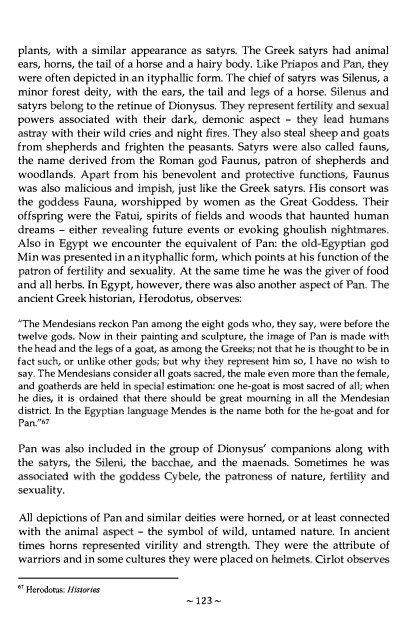Create successful ePaper yourself
Turn your PDF publications into a flip-book with our unique Google optimized e-Paper software.
plants, with a similar appearance as satyrs. The Greek satyrs had animal<br />
ears, horns, <strong>the</strong> tail <strong>of</strong> a horse and a hairy body. Like and <strong>the</strong>y<br />
were <strong>of</strong>ten depicted in an ityphallic form. The chief <strong>of</strong> satyrs was Silenus, a<br />
minor forest deity, with <strong>the</strong> ears, <strong>the</strong> taU and <strong>of</strong> a horse. and<br />
satyrs to <strong>the</strong> retinue <strong>of</strong> Dionysus.<br />
powers associated with <strong>the</strong>ir dark, demonic aspect -<br />
with <strong>the</strong>ir wild cries and night They steal and<br />
from shepherds and frighten <strong>the</strong> peasants. Satyrs were also called fauns,<br />
<strong>the</strong> name derived from <strong>the</strong> Roman Faunus, patron <strong>of</strong> shepherds and<br />
woodlands. from his benevolent and Faunus<br />
was also malicious and just like <strong>the</strong> Greek satyrs. His consort was<br />
<strong>the</strong> Fauna, worshipped by women as <strong>the</strong> Great Goddess. Their<br />
<strong>of</strong>fspring were <strong>the</strong> Fatui, spirits <strong>of</strong> fields and woods that haunted human<br />
dreams - ei<strong>the</strong>r future events or evoking ghoulish<br />
Also in we encounter <strong>the</strong> equivalent <strong>of</strong> Pan: <strong>the</strong><br />
Min was presented in an ityphallic form, which points at his function <strong>of</strong> <strong>the</strong><br />
<strong>of</strong> and sexuality. At <strong>the</strong> same time he was <strong>the</strong> <strong>of</strong> food<br />
and all herbs. In Egypt, however, <strong>the</strong>re was also ano<strong>the</strong>r<br />
ancient Greek historian, Herodotus, observes:<br />
"The Mendesians reckon Pan among <strong>the</strong> eight gods who, <strong>the</strong>y say, were before <strong>the</strong><br />
twelve gods. Now in <strong>the</strong>ir painting and sculpture, <strong>the</strong> <strong>of</strong> Pan is made with<br />
<strong>the</strong> head and <strong>the</strong> <strong>of</strong> a as among <strong>the</strong> not he is to be in<br />
fact or unlike o<strong>the</strong>r but why him so, I have no wish to<br />
say. The Mendesians consider all goats <strong>the</strong> male even more than <strong>the</strong> female,<br />
and goa<strong>the</strong>rds are held in estimation: one he-goat is most sacred <strong>of</strong> when<br />
he dies, it is ordained that <strong>the</strong>re should be great mourning in all <strong>the</strong> Mendesian<br />
district. In <strong>the</strong> Mendes is <strong>the</strong> name both for <strong>the</strong> and for<br />
Pan."67<br />
Pan was also included in <strong>the</strong> group <strong>of</strong> Dionysus' companions along with<br />
<strong>the</strong> <strong>the</strong> <strong>the</strong> and <strong>the</strong> maenads. Sometimes he was<br />
sexuality.<br />
<strong>the</strong> <strong>of</strong> nature, and<br />
All depictions <strong>of</strong> Pan and similar deities were horned, or at least connected<br />
with <strong>the</strong> animal - <strong>the</strong> symbol <strong>of</strong> wild, untamed nature. In ancient<br />
times horns virility and strength. They were <strong>the</strong> attribute <strong>of</strong><br />
warriors and in some cultures <strong>the</strong>y were placed on OrIot nh










